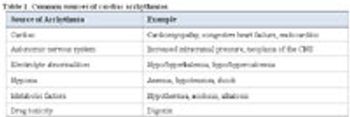Lara K. Maxwell, DVM, PhD, DACVCP
Articles by Lara K. Maxwell, DVM, PhD, DACVCP

Congestive heart failure (CHF) is not a primary disease; rather it is the manifestation of the failing heart that arises from neurohumoral compensation. The primary problems that underlie CHF can be diverse, but commonly involve myxomatous mitral valve disease (MMVD) or dilated cardiomyopathy (DCM) in dogs and hypertrophic cardiomyopathy in cats.

As their name implies, nonsteroidal aniti-inflammatory drugs (NSAIDs) are used in the treatment of inflammatory conditions, which are characterized by redness, swelling, heat, pain, and loss of function. Although the inflammatory response can be viewed as essentially protective and beneficial to the body, excessive inflammation in the face of progressive disease can promote the cycle of increasing damage and inflammation.

Chondroprotective agents are available as injectable and oral formulations. The injectable formulations are classified as drugs and are regulated by the FDA. The present discussion will focus on the more nebulous branch of chondroprotective agents, the nutraceuticals.

Small animal practitioners are well aware that "cats are not small dogs". However, are small dogs just miniaturized versions of their larger brothers and sisters? What about the effect of breed on therapeutics? The incredible diversity of dog breeds presents veterinarians with problems and opportunities inherent to the medical care for such a highly variable species.

In the therapy of neoplastic infections with cytotoxic drugs, there is little basis for the selective killing of the abnormal cells as opposed to the healthy cells in the body. There are only a few known differences in receptors and metabolism that are suitable drug targets at the present time.

Thromboembolic agents are indicated for a variety of conditions, ranging from disseminated intravascular coagulation to pulmonary thromboembolism in both dogs and cats. The selection of appropriate thromboembolic therapy will depend on the underlying condition and the goal of treatment.

Veterinarians are faced daily with the therapeutic challenge of treating species and conditions for which no approved drug exists. Other challenges include the differing needs of patients that have species-specific requirements, as well as individual needs for palatability and formulation.

Identification and correction of the underlying causes of arrhythmias are key to their long-term, successful management. For instance, in a cat with atrial standstill as a result of hyperkalemia from urethral obstruction, the arrhythmia is best addressed by correction of the underlying problem, hyperkalemia, as primary antiarrhythmic therapy is generally unsuccessful when such electrolyte abnormalities are present.

Thromboembolic agents are indicated for a variety of conditions, ranging from disseminated intravascular coagulation to pulmonary thromboembolism in both dogs and cats.

Identification and correction of the underlying causes of arrhythmias are key to their long-term, successful management.

As their name implies, nonsteroidal anti-inflammatory drugs (NSAIDs) are used in the treatment of inflammatory conditions, which are characterized by redness, swelling, heat, pain, and loss of function.

In the therapy of neoplastic infections with cytotoxic drugs, there is little basis for the selective killing of the abnormal cells as opposed to the healthy cells in the body.

Congestive heart failure (CHF) is not a primary disease; rather it is the clinical manifestation of the failing heart and describes a syndrome characterized by complex interactions of the heart with neurohumoral compensatory responses.





